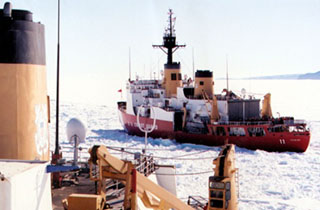The Coast Guard released requirements for two new heavy icebreakers and an acquisition timeline, riding a wave of bipartisan support for building a new high-latitudes capability as retreating sea ice opens more of the Arctic to shipping, mineral exploration and tourism.
“I want stable requirements that I can bring to industry,” Coast Guard Commandant Paul F. Zunkufnt said in a Jan. 13 talk to the Center for Strategic and International Studies in Washington, D.C., shortly before the design call went out. “We’re giving everyone a head start on this.”
Among imagined scenarios in the icebreaker proposal, the new ships must be capable of managing “a mass search and rescue” if a cruise ship gets in trouble in the ice.
Zunkufnt said that hazard is already real, in regions with “little or no” search and rescue infrastructure. The cruise ship Crystal Serenity will be in the Northwest Passage in August and September, with 1,700 persons on board and staterooms sold for $21,500, he said.
“Every stateroom is filled,” Zunkufnt said. “I reached out to the cruise industry and I said, ‘I hope none of you are thinking about this.’ And they said, ‘Are you kidding me? At these prices and earnings? Absolutely.’”
The Coast Guard also wants to build new international environmental standards into the ships, and is asking the industry how the International Maritime Organization’s Polar Code may affect design and construction.
The Coast Guard wants to have a formal request for proposals out in the first quarter of fiscal year 2017 — the last months of calendar year 2016 — and have contracts out in fiscal years 2018 or 2019. Icebreaker supporters in Congress and President Obama want a program to build the first ship by 2020.
At a projected cost of $1 billion each, the future icebreakers need power to clear channels 83’ wide — as does the sole heavy U.S. icebreaker in operation now, the 399’x83’ Polar Star — cutting through ice thickness of 6’ at a steady 3 knots, according to capability requirements outlined by the Coast Guard’s Acquisitions Directorate. The ships must also be capable of surging through ice ridges 21’ thick, according to the document.
With a minimum range of 21,500 nautical miles at 12 knots, the ships will have sustained speed of 15 knots in ice-free waters, ability to operate without replenishment for 80 to 90 days, and be capable of annual operations between 3,300 hours and 4,050 hours. In winter-over conditions, the ships must be able to sustain themselves for up to 210 days.
They must be capable of aviation operations and over-the-horizon boat launch in recovery in seas up to 8’ and able to tow in seas up to 10’. Crew size is preliminary, but the Coast Guard estimates it will be between 100 and 150, plus up to 50 scientists and other personnel.
The document is a prelude to the Coast Guard seeking proposals from the industry, and the agency is looking for an event in March to sit down with prospective shipyards. Both Huntington Ingalls Industries and General Dynamics have expressed interest.
Like the 1970s-built heavy icebreakers Polar Sea and Polar Star, the new ships will be built for a 40-year service life. The Coast Guard’s 420’x82’ medium icebreaker Healy was built in 1999.
Polar Star was at the McMurdo Station in Antarctica this week, after a voyage marked by problems again with aged equipment.
“I lose sleep when Polar Star had a major console failure on the way down there three weeks ago,” Zunkufnt said.
Part of the Coast Guard’s new icebreaker program in the next 18 months will be assessing Polar Star’s needs, and whether sister ship Polar Sea should be recommissioned or kept as a parts bank.
“We’ll do a material assessment on that to decide if we want to bring it back to life,” Zunkufnt said.
Studies by the Coast Guard and the General Accounting Office have projected that the U.S. needs up to three heavy and three medium icebreakers to meet increasing demands of navigation, national security and science as summer sea ice cover gets smaller in the Arctic. By contrast Russia has 42 icebreaking vessels and may build a dozen more, and even China has two icebreakers to be a player in the polar regions.




